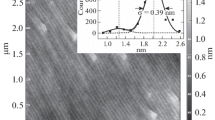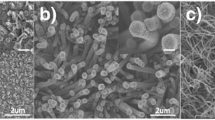Abstract
In this study, we show that the volatile monoxide species generated during the active oxidation of Ge and Si substrates can be utilized in the presence of Au catalytic nanoparticles to nucleate and grow GeOx and SiOx nanowires. A simple thermodynamic model is developed to ascertain the critical O2 partial pressure as a function of temperature required for the active oxidation of Ge and Si substrates and is experimentally verified. The ideal conditions for uniform nanowire growth across the substrate are shown to be primarily dependent on the O2 partial pressure, the annealing temperature and thicknesses of the surface oxide, and deposited Au. The role of a metastable surface oxide separating the active oxidation and NW nucleation processes is also discussed.





Similar content being viewed by others
References
S. Barth, F. Hernandez-Ramirez, J.D. Holmes, and A. Romano-Rodriguez: Synthesis and applications of one-dimensional semiconductors. Prog. Mater. Sci. 55(6), 563 (2010).
Z.L. Wang: Oxide nanobelts and nanowires—Growth, properties and applications. J. Nanosci. Nanotechnol. 8(1), 27 (2008).
C.N.R Rao, F.L. Deepak, G. Gundiah, and A. Govindaraj: Inorganic nanowires. Prog. Solid State Chem. 31(1/2), 5 (2003).
R. Takagi: Growth of oxide whiskers on metals at high temperature. J. Phys. Soc. Jpn. 12(11), 1212 (1957).
A. Weiss and A. Weiss: Über Siliziumchalcogenide VI. Zur Kenntnis der faserigen Siliciumdioxyd-modifikation. Z. Anorg. Allg. Chem. 276(1/2), 95 (1954).
R.B. Sosman: The Phases of Silica (Rutgers University Press, Piscataway, NJ, 1965).
E.A. Gulbransen: Thermochemistry and oxidation of refractory metals at high temperature. Corrosion 26(1), 19 (1970).
T. Engel: The interaction of molecular and atomic oxygen with Si(100) and Si(111). Surf. Sci. Rep. 18(4), 91 (1993).
J.R. Engstrom, D.J. Bonser, M.M. Nelson, and T. Engel: The reaction of atomic oxygen with Si(100) and Si(111). 1. Oxide decomposition, active oxidation and the transition to passive oxidation. Surf. Sci. 256(3), 317 (1991).
T.H. Kim, A. Shalav, and R.G. Elliman: Active-oxidation of Si as the source of vapor-phase reactants in the growth of SiOx nanowires on Si. J. Appl. Phys. 108(7), 076102 (2010).
A. Shalav, T. Kim, and R.G. Elliman: SiOx nanowires grown via the active oxidation of silicon. Sel. Top. Quant. Elect. (2010, in press).
J. Vanhellemont and E. Simoen: Brother silicon, sister germanium. J. Electrochem. Soc. 154(7), H572 (2007).
M. Micoulaut, L. Cormier, and G.S. Henderson: The structure of amorphous, crystalline and liquid GeO2. J. Phys. Condens. Matter 18(45), R753 (2006).
K. Prabhakaran, F. Maeda, Y. Watanabe, and T. Ogino: Distinctly different thermal decomposition pathways of ultrathin oxide layer on Ge and Si surfaces. Appl. Phys. Lett. 76(16), 2244 (2000).
O. Knacke, O. Kubaschewski, and K. Hesselman: Thermochemical Properties of Inorganic Substances, 2 ed. (Springer-Verlag, Berlin, 1991).
M. Chase: NIST-JANAF Thermochemical Tables—4th ed., J. of Phys. Chem. Ref. Data, Monograph No. 9 (1998).
B.J. McBride, S. Gordon, and M. Reno: Thermodynamic data for fifty reference elements, NASA Technical Memorandum 3287/REV1 (2001).
A.T. Dinsdale: SGTE data for pure elements. CALPHAD 15(4), 317 (1991).
K. Nagashio, C.H. Lee, T. Nishimura, K. Kita, and A. Toriumi: Thermodynamics and kinetics for suppression of GeO desorption by high pressure oxidation of Ge, in CMOS Gate-Stack Scaling-Materials, Interfaces and Reliability Implications, edited by A.D. Demkov, B. Taylor, H.R. Harris, J.W. Butterbaugh, and W. Rachmady (Mater. Res. Soc. Symp. Proc. 1155, Warrendale, PA, 2009), 1155-C06-02, p. 157.
C.H. Lee, T. Tabata, T. Nishimura, K. Nagashio, K. Kita, and A. Toriumi: Ge/GeO2 interface control with high-pressure oxidation for improving electrical characteristics. Appl. Phys. Expr. 2(7), 071404 (2009).
E.A. Gulbransen and S.A. Jansson: High-temperature oxidation, reduction, and volatilization reactions of silicon and silicon-carbide. Oxid. Met. 4(3), 181 (1972).
J.W. Hinze and H.C. Graham: Active oxidation of Si and SiC in viscous gas-flow regime. J. Electrochem. Soc. 123(7), 1066 (1976).
C. Gelain, A. Cassuto, and P. Legoff: Kinetics and mechanism of low-pressure, high-temperature oxidation of silicon. Oxid. Met. 3(2), 139 (1971).
F.W. Smith and G. Ghidini: Reaction of oxygen with Si(111) and (100)—critical conditions for the growth of SiO2. J. Electrochem. Soc. 129(6), 1300 (1982).
C. Wagner: Passivity during the oxidation of silicon at elevated temperatures. J. Appl. Phys. 29(9), 1295 (1958).
A. Molle, M.N.K Bhulyan, G. Tallarida, and M. Fanciulli: Formation and stability of germanium oxide induced by atomic oxygen exposure. Mat. Sci. Semicond. Process. 9(4/5), 673 (2006).
P.K. Sekhar and S. Bhansali: Manufacturing aspects of oxide nanowires. Mater. Lett. 64(6), 729 (2010).
P.Y. Chevalier: A thermodynamic evaluation of the Au-Ge and Au-Si systems. Therm. Acta 141, 217 (1989).
M. Liehr, H. Dallaporta, and J.E. Lewis: Defect formation in SiO2/Si(100) by metal diffusion and reaction. Appl. Phys. Lett. 53(7), 589 (1988).
Acknowledgment
The Australian Research Council is gratefully acknowledged for financial support. The Australian National University nodes of the Australian Nano Fabrication Facility and the Australian Microscopy & Microanalysis Research Facility, both established under the Australian National Cooperative Research Infrastructure Strategy, are acknowledged for access to the facilities used in this work.
Author information
Authors and Affiliations
Corresponding author
Rights and permissions
About this article
Cite this article
Shalav, A., Collin, G.H., Yang, Y. et al. GeOx and SiOx nanowires grown via the active oxidation of Ge and Si substrates. Journal of Materials Research 26, 2240–2246 (2011). https://doi.org/10.1557/jmr.2011.150
Received:
Accepted:
Published:
Issue Date:
DOI: https://doi.org/10.1557/jmr.2011.150




